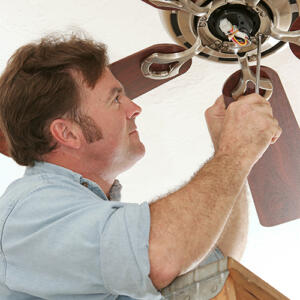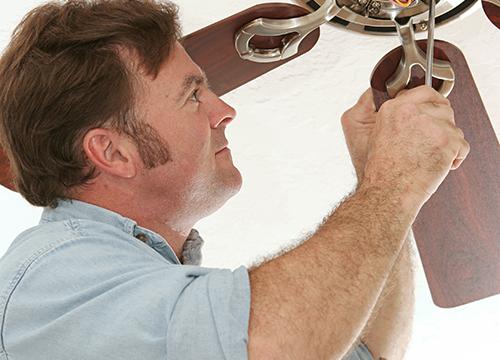 As the weather warms up, many of us will be reaching up to turn on your ceiling fan.
As the weather warms up, many of us will be reaching up to turn on your ceiling fan.
These are good for dispersing cool air throughout a house, adding air flow to a room and more, but contrary to common perception, ceiling fans don’t actually make a room cooler.
A thermostat under a fan going full blast will read the same temperature after the fan is turned off.
However, the wind chill effect can make a room feel as much as seven or eight degrees cooler.
Ceiling fans use a fraction of the energy an HVAC system uses, as well.
Ceiling fans can actually help warm rooms in the winter, too. Most ceiling fans have a directional switch on the fan housing.
If you reverse a fan’s rotation and run it at low speed, it will gently draw warm air upwards from floor-based heat registers. Just be sure to flip the switch and reverse direction again once the weather warms up!
Installing a fan can be very easy, but only if you follow the directions included with your new fan kit and keep a few safety tips in mind.
Light or no light?
This is a very important factor to keep in mind when shopping for, and installing, your new ceiling fan. There are four possibilities here.
Please note that these are general guidelines – always follow the installation instructions on your new fan package.
If your old ceiling fan has a light fixture attached, but your new fan does not: during the attachment process, simply cover the light wires and tuck them back in the housing.
On the other hand, if the old ceiling fan has a light fixture, and your new fan does: connect the old light wires to the new light kit, and secure it to the housing with screws.
If your old ceiling fan does not have a light, and your new fan does not: you don’t have anything to worry about!
If it does not have a light, and your new ceiling fan does: check the assembly and housing of your old fan as you remove it. Often, there is already clearly labeled wiring for lighting in the fixture, even if it is not used.
This may be wound together with the fan wiring.
If there is not wiring clearly labeled for a lighting kit, you will need to ask someone with experience for help, or hire an electrician.
Turn the Power Off
This means more than turning off the switch. You will need to cut the power off to the entire appliance.
Turn off the circuit breaker or fuse panel, depending on what your home has. It is only safe to remove the light fixture once you have done this.
You can test to see if the electricity has been cut off by turning the wall switches on and off, or even using a circuit tester on the light fixture.
You can then remove the light fixture and disconnect the fan’s wiring.
Remove the old fan
If the fan has a light, remove the light shade and light bulb(s). Remove the fan blades by removing the screws holding them in place.
If there is a light fixture on your old fan, remove the housing by removing the screws holding it in place.
Disconnect all of the old wires as you remove the housing, and remove the mounting bracket.
Remove the ceiling fan mounting bracket by removing the screws holding it in place.
Add the new fan
Screw in the new mounting bracket according to the directions on the package.
Connect the new wires, making sure the metal wires are in solid contact. Secure them with twist-on wire connectors, also known as “wire nuts.”
These small plastic caps twist electrical wires together, while protecting your fingers from the electricity while handling them.
Attach the central rod or canopy of the fan to the mounting bracket. This is the part of the fan that actually rotates.
Attach the fan blades to the mounting brackets with the screws included with the fan.
If there is a light on your new fan, connect the light kit and secure it with screws. Attach the light fixture as the instructions dictate.
Attach the included pull chains, if applicable.
Turn the circuit breaker or fuse back on, then turn on your new ceiling fan!







